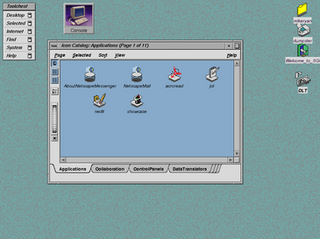Related Research Articles

IRIX is a discontinued operating system developed by Silicon Graphics (SGI) to run on the company's proprietary MIPS workstations and servers. It is based on UNIX System V with BSD extensions. In IRIX, SGI originated the XFS file system and the industry-standard OpenGL graphics system.

Silicon Graphics, Inc. was an American high-performance computing manufacturer, producing computer hardware and software. Founded in Mountain View, California in November 1981 by James Clark, its initial market was 3D graphics computer workstations, but its products, strategies and market positions developed significantly over time.

Non-linear editing is a form of offline editing for audio, video, and image editing. In offline editing, the original content is not modified in the course of editing. In non-linear editing, edits are specified and modified by specialized software. A pointer-based playlist, effectively an edit decision list (EDL), for video and audio, or a directed acyclic graph for still images, is used to keep track of edits. Each time the edited audio, video, or image is rendered, played back, or accessed, it is reconstructed from the original source and the specified editing steps. Although this process is more computationally intensive than directly modifying the original content, changing the edits themselves can be almost instantaneous, and it prevents further generation loss as the audio, video, or image is edited.

Autodesk Maya, commonly shortened to just Maya, is a 3D computer graphics application that runs on Windows, macOS, and Linux, originally developed by Alias and currently owned and developed by Autodesk. It is used to create assets for interactive 3D applications, animated films, TV series, and visual effects.
Shake is a discontinued image compositing package used in the post-production industry developed by Nothing Real for Windows and later acquired by Apple Inc. Shake was widely used in visual effects and digital compositing for film, video and commercials. Shake exposed its node graph architecture graphically. It enabled complex image processing sequences to be designed through the connection of effects "nodes" in a graphical workflow interface. This type of compositing interface allowed great flexibility, including the ability to modify the parameters of an earlier image processing step "in context". Many other compositing packages, such as Blender, Blackmagic Fusion, Nuke and Cineon, also used a similar node-based approach.
Houdini is a 3D animation software application developed by Toronto-based SideFX, who adapted it from the PRISMS suite of procedural generation software tools.

Vegas Pro is a professional video editing software package for non-linear editing (NLE). The first release of Vegas Beta was on 11 June 1999. The software is limited to machines running Windows as an operating system.
Autodesk Media and Entertainment is a division of Autodesk which offers animation and visual effects products, and was formed by the combination of multiple acquisitions. In 2018, the company began operating as a single operating segment and reporting unit.
Ron Brinkmann, a visual effects supervisor and a founding employee of Sony Imageworks. While there he was nominated for a BAFTA Award for Best Special Visual Effects for his work on the movie Speed. He later co-founded Nothing Real, a software company that produced the digital compositing application Shake. Nothing Real was acquired in 2002 by Apple.

Nuke is a node-based digital compositing and visual effects application first developed by Digital Domain and used for television and film post-production. Nuke is available for Windows, macOS, and RHEL/CentOS. Foundry has further developed the software since Nuke was sold in 2007.

Sony Pictures Imageworks Inc. is a Canadian visual effects and computer animation studio headquartered in Vancouver, British Columbia and Montreal, Quebec, with an additional office on the Sony Pictures Studios lot in Culver City, California. SPI is a unit of Sony Pictures Entertainment's Motion Picture Group.
3Delight is a 3D computer graphics software that runs on Microsoft Windows, macOS and Linux. Developed by Illumination Research, it is both a photorealistic and NPR path tracing offline renderer based on its NSI API scene description and on OSL for shading. It has been used to render full CGI animation and VFX for numerous feature films. It comes with supported, open source plug-in integrations for several DCC applications, such as Maya, Houdini, Cinema4D, Katana, OpenUSD Hydra, and a democratic free license that allows for commercial use. It also provides a fully distributed cloud rendering service called 3Delight Cloud.

Vue is a software tool for world generation by Bentley Systems with support for many visual effects, animations and various other features. The tool has been used in several feature-length movies.

Softimage|3D is a discontinued high-end 3D graphics application developed by Softimage, Co., which was used predominantly in the film, broadcasting, gaming, and advertising industries for the production of 3D animation. It was superseded by Softimage XSI in 2000.
DrQueue is an open source software tool used to manage a render farm. It provides distributed render queueing on a per-frame basis and management of these tasks. It is primarily used for animations used as visual effects in films and advertising.
Gnomon is a for-profit college in Hollywood, California. The school focuses on artistic and technical training for careers in the visual effects and games industries. It was founded in 1997 by Alex Alvarez. Gnomon was originally created to train industry artists, though it has evolved into a more all-encompassing art school. In March 2011, Fast Company included Gnomon in its list of the 10 Most Innovative Companies in Film.

Stephen Rosenbaum is an American visual effects artist and supervisor, and has worked on numerous movie, tv and music productions, including six that have won Academy Awards. He has been nominated three times for an Academy Award and two times for a BAFTA Award. He has won both awards twice for his contributions on Forrest Gump and Avatar, and has played artist and supervisor roles on such pioneering films as Jurassic Park, Terminator 2: Judgment Day, The Abyss, X2: X-Men United, Death Becomes Her, Contact and The Perfect Storm.
Alembic is an interchangeable computer graphics file format developed by Sony Pictures Imageworks and Industrial Light & Magic. It was announced at SIGGRAPH 2011, and has been widely adopted across the industry by visual effects and animation professionals.
OpenFX (OFX), a.k.a. The OFX Image Effect Plug-in API, is an open standard for 2D visual effects or compositing plug-ins. It allows plug-ins written to the standard to work on any application that supports the standard. The OpenFX standard is owned by The Open Effects Association, and it is released under a 'BSD' open source license. OpenFX was originally designed by Bruno Nicoletti at The Foundry Visionmongers.
Natron is a free and open-source node-based compositing application. It has been influenced by digital compositing software such as Avid Media Illusion, Apple Shake, Blackmagic Fusion, Autodesk Flame and Nuke, from which its user interface and many of its concepts are derived.